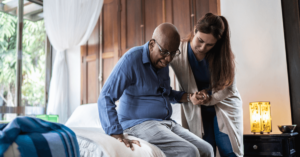Statistics on Nursing Home Falls


Unfortunately falls in nursing homes are common and can easily cause a serious nursing home injury to occur. Even more alarming is that a study published by the National Institutes of Health (NIH) found that only about 57% of nursing home falls are reported.
With such poor reporting standards, it is difficult to get accurate nursing home falls statistics. However, from what is known, falls in nursing homes are far too common.
Here are some important nursing home falls statistics:
- Between 50% and 75% of nursing facility residents fall each year. This is twice the chance of falling for older adults living in a community setting.
- Roughly 1,800 individuals living in nursing facilities die from falls in any given year.
- About 5% of U.S. adults aged 65 and older reside in nursing homes, but deaths due to falls by nursing home residents make up 20% of deaths in the same age group.
- About 1 in 3 nursing home residents who fall will fall two or more times in a year.
- About 1 in 10 nursing home falls results in serious injury.
- Between 2%-6% of nursing home falls result in some type of fracture.
- On average, a nursing home with 100 residents reports about 100-200 falls yearly.
- The average rate of falls is 2.6 falls per person in any given year.
- Between 16%-27% of nursing home falls are caused by environmental hazards, such as equipment in the hallways.
- About 35% of injuries due to falls occur in residents who cannot walk on their own.
In cases where nursing home falls result in death, survivors may be able to file a wrongful death lawsuit. While nothing can bring your loved one back, getting justice by forcing nursing homes to pay for their negligence has helped many families find closure.
Why Are Falls in Nursing Homes So Common?
Nursing home falls are common since most people living in nursing homes are there because they are too frail or sick to live independently. Often, this means residents are already at an increased risk of falls.
Nursing home residents tend to be older, have increased difficulty walking, and suffer from more chronic health conditions when compared to seniors living in community settings.
Muscle weakness and gait problems are the most common causes of falls among elderly residents, accounting for about 24% of nursing home falls.
Nursing home residents may also have increased memory problems, difficulty conducting daily activities, and trouble taking care of themselves and getting around.
Even with this increased risk, most falls are preventable, and in these instances, nursing home falls could be a sign of nursing home negligence. Knowing the cause of nursing home falls is the best way to determine if they were avoidable.
What Causes Nursing Home Falls?
Falling is often an indication of other health conditions. This can make preventing falls in nursing home patients challenging.
Medical conditions that may cause nursing home falls include:
- Being underweight or overweight
- Epilepsy or other seizure disorders
- Having an active hip fracture
- Huntington’s disease
- History of falls
- Incontinence that creates the need to get up quickly and frequently
- Medications, such as antidepressants, tranquilizers, or sedatives
- Severe cognitive impairment, such as Alzheimer’s disease
- Using a walker, cane, or crutch
- Wandering behaviors
- Wearing corrective lenses
In addition to medical issues contributing to nursing home falls, other causes include hazards that could have been avoided.
Hazards that may cause nursing home falls include:
- Beds that are set too high
- Cluttered living spaces
- Hard-to-manage clothing
- Inaccessible personal items
- Ineffective wheelchair brakes
- Missing equipment parts
- Poor lighting
- Poorly fitted/maintained wheelchairs
- Uneven floors
- Unstable bed wheels
- Unstable furniture
- Wet floors
Nursing home falls may also be caused by difficulty getting from one place to another, such as walking from a chair to a bed, poorly fitted shoes, poor foot care, and the improper use of walking aids like walkers and canes.
Nursing Home Injuries Due to Falls
Nursing home falls tend to have serious consequences. This can be true for anyone, especially for frail residents.
Some common injuries related to nursing home falls include:
- Broken bones
- Concussions
- Fractures
- Spinal injuries
Nursing home falls that cause head injury can be especially problematic because residents may be on blood thinners, which can increase their risk of uncontrolled bleeding. This dangerous combination could quickly lead to traumatic brain injury or even death.
Nursing home injuries due to falls can decrease residents’ quality of life and limit their ability to get around. Even if falls do not cause harm, residents can develop a fear of falling and refuse to be as active as they once were. This can lead to social isolation and reduced quality of life.
How to Prevent Falls in a Nursing Home


For the most part, families are at the mercy of long-term care facilities to have fall prevention strategies in place. Nursing home staff should be trained on common risk factors and what interventions they must take to prevent falls.
However, there are also some proactive measures you can ask nursing home staff members to take, especially if your loved one is at high risk for falls.
Requests you can make for preventing falls in nursing home patients include:
- Bedside commodes or adult diapers
- Elevated toilet seats
- Floor cushions to absorb shock
- Grab bars
- Low-profile beds
- Mobility aids, such as wheelchairs, canes, or walkers
- Monitors, bed alarms, or personal alarms
- Nightlights
The bottom line is that the facility is responsible for preventing falls. Families may have legal remedies when a resident falls in a nursing home if proper precautions were not taken.
Can I Sue After a Fall in a Nursing Home?
You may be able to sue if your loved one was harmed due to a fall in a nursing home. Nursing homes have an obligation to follow state and federal guidelines designed to keep residents safe. Failing to do so could be considered negligence, and you may be able to sue for nursing home neglect.
Nursing home falls lawsuits may allow families to access compensation for medical costs. This money can also be used to transfer your loved one to a safer facility.
Nursing Home Falls Lawsuits
Nursing home falls can cause irreversible damage to residents’ health, well-being, and overall quality of life. Families put their trust in nursing homes to protect their loved ones from harm.
Filing a nursing home lawsuit may be the only way to get justice when facilities fail to keep residents safe. A successful lawsuit can get you the money you need to help your loved one recover.
Compensation from nursing home falls lawsuits can help pay for:
- Funeral costs
- Household expenses (groceries, utilities)
- Lost wages
- Medical bills
- Mortgages or rent
- Other bills or expenses
- Physical therapy
Additionally, nursing home falls lawsuits help ensure that facilities are forced to make changes so future residents are not harmed.
If you are thinking of filing a nursing home lawsuit, it is important to remember that not all lawyers are the same. Finding a nursing home abuse lawyer with experience handling similar cases to yours can help ensure you get the best results possible.
Nursing Home Abuse Lawyers
Nursing Home Abuse Center works with a national network of nursing home lawyers. We can connect you with a reputable personal injury law firm with skilled nursing home lawyers in your state. They can walk you through your legal options related to a nursing home fall.
If you believe your loved one has been injured in a nursing home, our team can help you determine your next steps. To learn more, get a free case review today.
FAQs About Nursing Home Falls
How can families prevent falls in nursing home facilities?
Preventing falls in the nursing home is primarily up to the facility itself. Ensuring the nursing home has proper fall prevention protocols is the best place to start. It is equally important, however, to ensure they are equipped to follow these protocols by having adequate staff and maintaining a safe environment.
How can families investigate nursing home falls?
When nursing home falls occur, the first thing to do is get an immediate medical examination. Brain injuries or other unseen harm can quickly lead to death in frail seniors.
You should then talk with the nursing home to find out how the fall happened. You may wish to contact a nursing home abuse lawyer to evaluate the situation and help determine your legal options.
Who regulates nursing home falls prevention?
State and federal laws help protect residents from nursing home falls. These laws are designed to keep nursing home residents safe from abuse and neglect, including accidents such as falls that cause harm.
What is the federal regulation on nursing home falls?
The laws related to nursing home falls can be found in Title 42 of the Code of Federal Regulations (CFR). According to the law, nursing home facilities must ensure that the environment is free from hazards and that each resident has adequate supervision to prevent accidents.
What are the legal remedies when a resident falls in a nursing home?
Victims of preventable nursing home falls that cause injury can have their cases reviewed by an experienced nursing home falls attorney. The attorney will determine if victims can file a nursing home abuse lawsuit and pursue legal compensation if available.


